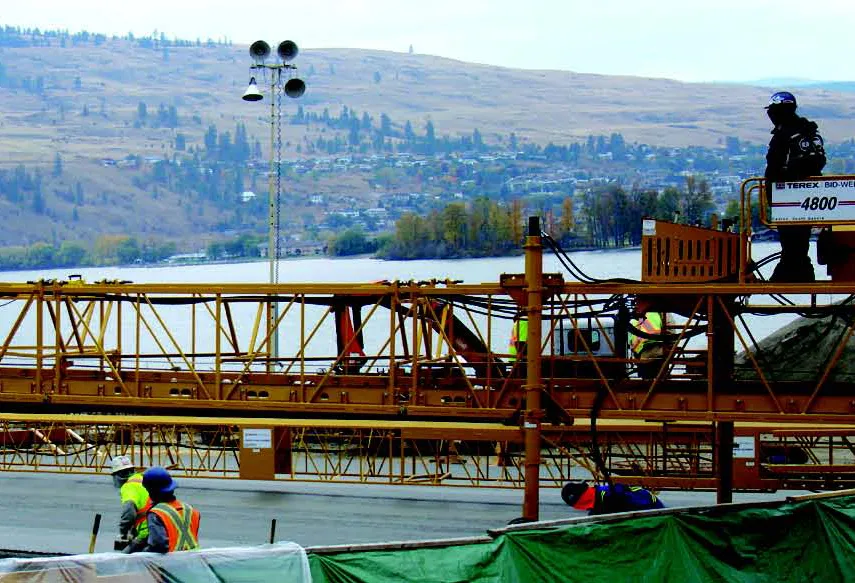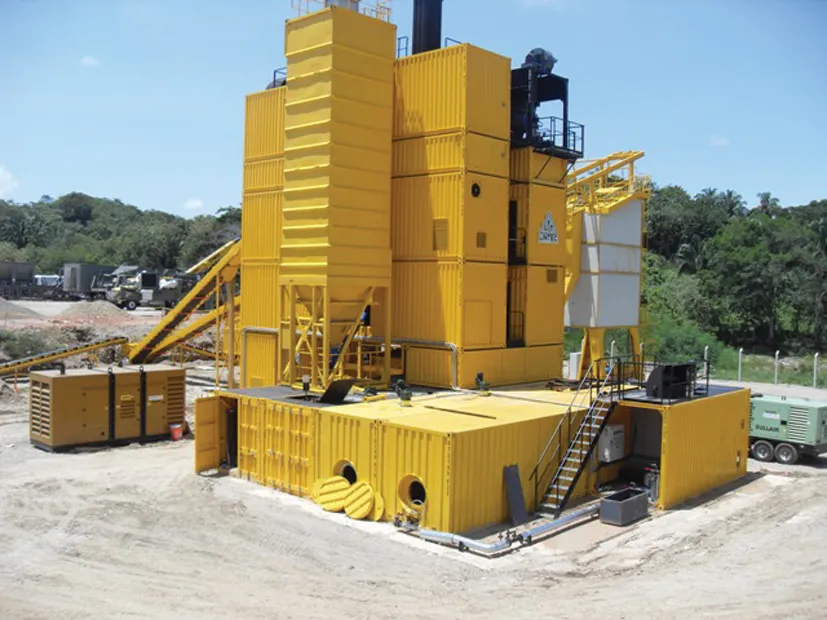Several aspects factor into choosing the proper concrete dowel drill - Randy Stevens. The concrete paving industry has seen significant changes to dowel drilling equipment over the years. Many years ago only hand-held models existed and when the first hydraulic drills were launched over 30 years ago, these increased production and reduced labour needs. Since that time pneumatic drills, have come to market and these are driven by air compressors, which are common on many worksites while the units also have l
April 11, 2012
Read time: 11 mins

Several aspects factor into choosing the proper concrete dowel drill - Randy Stevens
The concrete paving industry has seen significant changes to dowel drilling equipment over the years. Many years ago only hand-held models existed and when the first hydraulic drills were launched over 30 years ago, these increased production and reduced labour needs.Since that time pneumatic drills, have come to market and these are driven by air compressors, which are common on many worksites while the units also have low maintenance needs. The concept has continued to evolve and drills are now offered in various styles, differing in operation and production capabilities.
There are three primary categories of pneumatic concrete dowel drills: on-grade; slab-rider (or on-slab); and equipment-mounted. For these types, design and operation characteristics differ.
An on-grade drill works on the subgrade and may be stationary, or have wheels that allow it to move along the surface. On-grade drills tend to be smaller, making them easy to move and reposition when needed. Even larger, self-propelled on-grade models are designed with features for mobility and smooth, accurate operation.
Though they operate in much the same way as on-grade models, the slab-riding units have different characteristics. Instead of operating down in the grade, these work from on top of the slab and leave the subgrade undisturbed. They are typically larger than on-grade models, but designed to make manoeuvrability and steering smooth. Additionally, some are self-propelled to reduce operator fatigue and boost mobility to the next drilling area. Some on-slab units can be converted for on-grade operation, which is useful for contractors carrying out various drilling projects.
An equipment-mounted unit is attached to a machine such as a backhoe loader, and the drill sets down on the slab for reference. The backhoe operator positions the drill, while the drill operator guides it into place from ground level, making use a simple and efficient two-man process.
multi-gang drill machine
On-grade models operate on the sub-grade level and are easy to position from one patch to the next
Equipment-mounted models offer their own features to boost versatility and productivity. Many are designed for fast positioning, some with 360° capabilities to quickly drill opposite sides of a slab without moving the carrier machine. Others feature adjustable spacing with precise shifting capabilities for accuracy on large slabs requiring numerous, identical holes.
The three different classes all share characteristics but to meet different jobsite and production requirements, each model offers various options. Both on-grade and on-slab models are available in single-gang configurations, while all three offer
multi-gang configurations.
But rather than a matter of personal preference, drill selection centres on the application and all characteristics of the job must be considered. A major factor is how many total holes are to be drilled and others include conditions, deadlines, expected production rate and working shift times.
In general terms, a residential kerb-and-gutter pour is going to require a different drill than a larger airport paving job. But each jobsite comes with its own characteristics, one key factor being available space in which to work. If space is limited, an on-slab is eliminated and on-grade is going to be the best choice. Additionally, restricted space may limit the number of gangs on the drill. By contrast in larger projects like airport paving jobs, space is not an issue and a larger on-slab model can be ideal.
Specification issues may also affect model choice and engineers often specify that the subgrade cannot be disturbed on a project, eliminating an on-grade model. And some engineers favour models that ride on the slab because they believe that this will reduce variances compared with operating off the subgrade, though in reality the accuracy may be similar. Patch size is another issue that can dictate drill choice. A job requiring patches only 914mm wide will suit an on-grade model, the only drill compact enough.
on-slab drill
On jobsites where space is not at a premium, on-slab drills offer fast, easy mobility and positioning
In addition to space and specifications other jobsite characteristics affect drill choice, and in particular, mobility. Of the three models, an on-grade drill is lightest and easiest to transport, while its larger size means an on-slab drill must be towed on a trailer. But an on-slab drill does not need to be placed down in the subgrade and its wheels may allow it to be moved from one patch to the next on the jobsite. This makes it ideal for full-depth repair jobs where patches are located in close proximity to one another.
Larger full-depth repair projects on highways often consist of multiple intermittent patches. Purely from a mobility standpoint, these types of projects may require a machine-mounted model. Rather than load an on-grade or on-slab drill and move it to each new patch, the machine-mounted drill remains attached, and is simply lifted up and driven to the next patch by the carrier. A highway project with live traffic leaves virtually no room to move an on-slab or on-grade unit from patch to patch, while a backhoe loader can drive through the work zone to a new area. Jobsite conditions play a major role but other factors influence the final choice. An in-depth assessment of jobsite factors will help the choice of single or multi-gang selection and the total number of holes to be drilled is crucial.
Because every project has different requirements for the number of holes needed, drills are offered with different gang options and maximum efficiency is a key consideration for selection. Although high productivity is always a good thing, the cost/benefit relationship must be weighed. It is not cost effective to purchase a complex multi-gang unit when a single-gang drill is capable of doing the job. Additionally, air requirements increase with each function and a multi-gang drill may be inoperable on a jobsite using a smaller air compressor.
A starting point in the selection process is the total number of holes to be drilled. In general terms, a single-gang drill is ideal for jobs requiring several hundred to just a few thousand holes. When a project moves up into 5,000-10,000 holes, a two-gang drill may be appropriate, and so on. In the largest projects with hundreds of thousands of holes, multiple drills may be required. But the total number of holes may not dictate gang requirements, as other factors can carry more weight. Each jobsite’s requirements bring in shades of grey.
equipment mounted drill
Highway full-depth repair often constitutes an equipment mounted drill, both for mobility and productivity reasons
While the entire project may require several thousand holes, various factors may limit how many can be drilled at once. In some instances a single gang unit may be more efficient than a multi-gang drill. On the other hand, a job requiring just a few thousand holes but has a tight deadline may require a higher production drill than originally thought.
A jobsite may only allow a set number of holes to be drilled at a time, and in a period of time. A concrete slab needs time to set before it can be drilled into, and often several individual pours are required on a project. When looking at just the sheer volume of holes, a multi-gang drill may seem suitable but further examination may reveal a smaller drill to be more economical.
In addition, site conditions may only allow work between certain hours of the day or night, such as on busy highways where minimal traffic interruption is allowed. Where production rates have to be high, a multi-gang model might be necessary.
The primary field of work the company carries out also needs to be considered and as a drill is an investment, the long-term view should be taken into account. There are numerous options available in concrete dowel drills and advancements have made it possible to find the ideal drill for every project.
Equipment-mounted models offer their own features to boost versatility and productivity. Many are designed for fast positioning, some with 360° capabilities to quickly drill opposite sides of a slab without moving the carrier machine. Others feature adjustable spacing with precise shifting capabilities for accuracy on large slabs requiring numerous, identical holes.
The three different classes all share characteristics but to meet different jobsite and production requirements, each model offers various options. Both on-grade and on-slab models are available in single-gang configurations, while all three offer
multi-gang configurations.
But rather than a matter of personal preference, drill selection centres on the application and all characteristics of the job must be considered. A major factor is how many total holes are to be drilled and others include conditions, deadlines, expected production rate and working shift times.
In general terms, a residential kerb-and-gutter pour is going to require a different drill than a larger airport paving job. But each jobsite comes with its own characteristics, one key factor being available space in which to work. If space is limited, an on-slab is eliminated and on-grade is going to be the best choice. Additionally, restricted space may limit the number of gangs on the drill. By contrast in larger projects like airport paving jobs, space is not an issue and a larger on-slab model can be ideal.
Specification issues may also affect model choice and engineers often specify that the subgrade cannot be disturbed on a project, eliminating an on-grade model. And some engineers favour models that ride on the slab because they believe that this will reduce variances compared with operating off the subgrade, though in reality the accuracy may be similar. Patch size is another issue that can dictate drill choice. A job requiring patches only 914mm wide will suit an on-grade model, the only drill compact enough.
In addition to space and specifications other jobsite characteristics affect drill choice, and in particular, mobility. Of the three models, an on-grade drill is lightest and easiest to transport, while its larger size means an on-slab drill must be towed on a trailer. But an on-slab drill does not need to be placed down in the subgrade and its wheels may allow it to be moved from one patch to the next on the jobsite. This makes it ideal for full-depth repair jobs where patches are located in close proximity to one another.
Larger full-depth repair projects on highways often consist of multiple intermittent patches. Purely from a mobility standpoint, these types of projects may require a machine-mounted model. Rather than load an on-grade or on-slab drill and move it to each new patch, the machine-mounted drill remains attached, and is simply lifted up and driven to the next patch by the carrier. A highway project with live traffic leaves virtually no room to move an on-slab or on-grade unit from patch to patch, while a backhoe loader can drive through the work zone to a new area. Jobsite conditions play a major role but other factors influence the final choice. An in-depth assessment of jobsite factors will help the choice of single or multi-gang selection and the total number of holes to be drilled is crucial.
Because every project has different requirements for the number of holes needed, drills are offered with different gang options and maximum efficiency is a key consideration for selection. Although high productivity is always a good thing, the cost/benefit relationship must be weighed. It is not cost effective to purchase a complex multi-gang unit when a single-gang drill is capable of doing the job. Additionally, air requirements increase with each function and a multi-gang drill may be inoperable on a jobsite using a smaller air compressor.
A starting point in the selection process is the total number of holes to be drilled. In general terms, a single-gang drill is ideal for jobs requiring several hundred to just a few thousand holes. When a project moves up into 5,000-10,000 holes, a two-gang drill may be appropriate, and so on. In the largest projects with hundreds of thousands of holes, multiple drills may be required. But the total number of holes may not dictate gang requirements, as other factors can carry more weight. Each jobsite’s requirements bring in shades of grey.
While the entire project may require several thousand holes, various factors may limit how many can be drilled at once. In some instances a single gang unit may be more efficient than a multi-gang drill. On the other hand, a job requiring just a few thousand holes but has a tight deadline may require a higher production drill than originally thought.
A jobsite may only allow a set number of holes to be drilled at a time, and in a period of time. A concrete slab needs time to set before it can be drilled into, and often several individual pours are required on a project. When looking at just the sheer volume of holes, a multi-gang drill may seem suitable but further examination may reveal a smaller drill to be more economical.
In addition, site conditions may only allow work between certain hours of the day or night, such as on busy highways where minimal traffic interruption is allowed. Where production rates have to be high, a multi-gang model might be necessary.
The primary field of work the company carries out also needs to be considered and as a drill is an investment, the long-term view should be taken into account. There are numerous options available in concrete dowel drills and advancements have made it possible to find the ideal drill for every project.
Randy Stevens is vice president of sales at E-Z Drill









